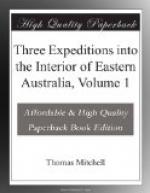Now it was obvious that had we, according to a suggestion sent to the government by Captain Sturt, proceeded on the 20th of May to Oxley’s Tableland, trusting to find abundance of water, the loss of our cattle would have been inevitable. To have reached that point we must have made one long day’s journey, and the distance thence to the nearest part of the Bogan could not have been accomplished in another. On the third day, the two preceding having been passed without water, the animals would have been unable to go further.
The specimen brought from the hill by Mr. Larmer appeared to be a quartzose conglomerate.
May 22.
I continued my journey along the Bogan, and in crossing and recrossing it once we passed several reaches of water. The country was generally open, and we encamped on another fine grassy plain after travelling about twelve miles. This day, in chasing an emu, I dropped a telescope which had been in my possession twenty-four years, having used it in the survey of many a field of battle.
THE PARTY FOLLOWED BY A CLAMOROUS TRIBE.
May 23.
We proceeded as usual. The calls of the natives, first heard at a distance in the woods, having become more loud and at length incessant, I answered them in a similar tone; and having halted the carts I galloped over a bit of clear rising-ground towards the place whence the voices came, followed by five men.
A PARLEY.
A tribe of eighteen or twenty natives were coming forward, but the sight of my horse galloping made those in the rear turn back, when I immediately alighted and walked towards them with a green tuft. The two foremost and strongest of the party came forward, and when I sat down they advanced with boomerangs in hand. Seeing that they retained these weapons, I arose, upon which they, understanding me immediately, threw the boomerangs aside. I then went up to the two in advance, the tribe following behind. The leader had lost an eye, and the three principal men seemed very strong fellows. I invited them to come forward, but they hesitated until my escort, which was still some way back, sat down. I mounted my horse to show the animal’s docility, and thus remove their dread of it; but they immediately turned to run, whereupon I alighted and led their chief a little nearer, but they were very unwilling to approach my party. At length I presented the one-eyed leader with a tomahawk, and they all sat down. This native seemed a manly intelligent fellow. To all which he appeared to comprehend of what I said his answer was “Awoy,” accompanied by a nod, as if he had said “O yes.” On my mentioning Goindura Gally, and making the signs of paddling a canoe, he pointed immediately to the westward. This term I understood from the Bungan tribe to mean saltwater; water being kally, gally, or gallo. So bungan gallo was the name of the lower Bogan, and Bogan gallo that of the upper Bogan. Goindura I understood to mean salt, in consequence of that word having been used by the chief of the Bogan when I showed him some salt.




